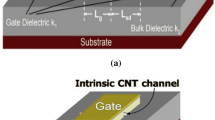Abstract
In this paper, a new fundamental cell in positive feedback source coupled logic is presented, which is an improvement over the existing fundamental cell employed in digital circuit design in various high resolution mixed-signal integrated circuits. The operation of the existing fundamental cell relies on using large sized transistor in its centre branch, resulting in significantly larger implementation area. The proposed fundamental cell incorporates multi-threshold transistor in the center branch thereby allowing designer to use reduce its dimension and hence the area. The impact of the proposed modification is examined by configuring the cell as two input exclusive OR (XOR2) gate. The behaviour is analysed in terms of static and propagation delay parameters which are modelled and a design procedure is also elaborated. The theoretical prepositions are verified by designing and simulating for various operating conditions using model parameters of 180 nm CMOS technology node. A maximum error of 27% is observed between the simulated and predicted parameters. The process variation study through Monte Carlo analysis and PVT variations identifies the proposed fundamental cell based circuit as less prone to variations in comparison to existing fundamental cell based counterparts. A full adder, as an application of the proposed fundamental cell, shows a significant (66%) area reduction while delay, power and PDP are within 4% of their corresponding values for the existing one.











Similar content being viewed by others
References
Kang, S.-M., Leblebici, Y., & Kim, C. (2014). CMOS digital integrated circuits: Analysis and design. (4th ed.). McGraw-Hill Higher Education.
Kiaei, S., Chee, S. H., & Allstot, D. (1990). CMOS source-coupled logic for mixed-mode VLSI. In Proceedings—IEEE international symposium on circuits and systems (Vol. 2, pp. 1608–1611). IEEE.
Allstot, D. J., Chee, S.-H., Kiaei, S., & Shrivastawa, M. (1993). Folded source-coupled logic vs. CMOS static logic for low-noise mixed-signal ICs. IEEE Transactions on Circuits and Systems I: Fundamental Theory and Applications, 40(9), 553–563
Musicer, J. M., & Rabaey, J. (2000). MOS current mode logic for low power, low noise CORDIC computation in mixed-signal environments. In Proceedings of the 2000 international symposium on Low power electronics and design—ISLPED’00 (pp. 102–107). New York, NY, USA: ACM Press.
Alioto, M., & Palumbo, G. (2005). Model and design of bipolar and MOS current-mode logic. Berlin/Heidelberg: Springer.
Alioto, M., Pancioni, L., Rocchi, S., & Vignoli, V. (2004). Modeling and evaluation of positive-feedback source-coupled logic. IEEE Transactions on Circuits and Systems I: Regular Papers, 51(12), 2345–2355
Pandey, N., Gupta, K., & Gupta, M. (2014). An efficient triple-tail cell based PFSCL D latch. Microelectronics Journal, 45(8), 1001–1007
Pandey, N., Gupta, M., & Gupta, K. (2015). A PFSCL based configurable logic block. In 2015 Annual IEEE India conference (INDICON) (pp. 1–4). IEEE.
Gupta, K., Shukla, P., & Pandey, N. (2016). On the implementation of PFSCL adders. In 2016 Second international innovative applications of computational intelligence on power, energy and controls with their impact on humanity (CIPECH) (pp. 287–291). IEEE.
Gupta, K., Mittal, U., Baghla, R., Shukla, P., & Pandey, N. (2016). On the implementation of PFSCL serializer. In 2016 3rd international conference on signal processing and integrated networks (SPIN) (pp. 436–440). IEEE.
Gupta, K., Mittal, U., Baghla, R., & Pandey, N. (2016). Implementation of PFSCL demultiplexer. In 2016 international conference on computational techniques in information and communication technologies (ICCTICT) (pp. 490–494). IEEE.
Tyagi, A., Pandey, N., & Gupta, K. (2016). PFSCL based Linear Feedback Shift Register. In 2016 international conference on computational techniques in information and communication technologies (ICCTICT) (pp. 580–585). IEEE.
Agrawal, R. K., Pandey, N., & Gupta, K. (2017). Implementation of PFSCL razor flipflop. In 2017 International conference on computing methodologies and communication (ICCMC) (pp. 6–11). IEEE.
Cheng, Y., & Hu, C. (2002). MOSFET modeling & BSIM3 user’s guide. Kluwer Academic Publishers.
Author information
Authors and Affiliations
Corresponding author
Additional information
Publisher's Note
Springer Nature remains neutral with regard to jurisdictional claims in published maps and institutional affiliations.
Appendix: Design of proposed fundamental cell XOR2 gate
Appendix: Design of proposed fundamental cell XOR2 gate
The design of the proposed fundamental cell XOR2 gate involves the method to determine the dimensions of various transistors for the given value of NM, Av and ISS. To begin, two bias currents namely, \({\text{I}}_{{\rm HIGH}}\) and ILOW corresponding to bias current for minimum PMOS dimensions for a given VSWING and the bias current corresponding to minimum NMOS dimensions are defined respectively.
For a given NM and Av values and using the static model expressions, the required value of VSWING, RP is calculated as:
Thus, the expression for \({\text{I}}_{{\rm HIGH}}\) can be written as:
where \({\text{R}}_{{\rm Pmin}}\) represents the resistance of minimum sized PMOS load transistor (Mr1-Mr4).
The calculated \({\text{I}}_{{\rm HIGH}}\) is compared with the required bias current ISS value. For values of ISS > IHIGH, RP will be less than RPmin and to calculate its value, LP is set to minimum LPmin and WP is calculated using (33) and [14].
Similarly, for values of ISS < IHIGH, RP will be greater than RPmin and to calculate its value, WP is set to WPmin and LP is calculated as per following expression, derived using (33) and [14] and mathematical simplification.
After this, the dimensions of transistors in the PDN is derived by substituting \(\frac{{\text{g}}_{{\rm mn}}{{\text{R}}}_{{\rm P}}}{2}=\sqrt{{2}{{\mu}}_{{\rm n}}{{\text{C}}}_{{\rm ox}}\frac{{\text{W}}_{{\rm N}}}{{\text{L}}_{{\rm N}}}\frac{1}{{\text{I}}_{{\rm ss}}}}\text{*}\frac{{\text{V}}_{{\rm SWING}}}{\text{p}}\) in the derived equation of Av in Sect. 3 for ISS > ILOW. The width WN of the PDN transistors is calculated as:
where LNmin is the minimum length of the NMOS transistor, and all other variables are as previously defined. For the case having ISS < ILOW, the WN for all the PDN transistors is kept at their minimum value, WNmin.
Rights and permissions
About this article
Cite this article
Sivaram, R., Gupta, K. & Pandey, N. Impact of multi threshold transistor in positive feedback source coupled logic (PFSCL) fundamental cell. Analog Integr Circ Sig Process 109, 173–185 (2021). https://doi.org/10.1007/s10470-021-01841-y
Received:
Revised:
Accepted:
Published:
Issue Date:
DOI: https://doi.org/10.1007/s10470-021-01841-y




